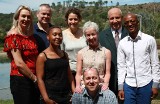
Academics from the Czech Republic, Egypt, Ghana, Namibia, Italy, Great Britain and South Africa participated in an important workshop recently where ways of harnessing bio-energy produced by algae were discussed.
Funded by the European Union’s Africa-Caribbean-Pacific Science and Technology programme, these leaders in the field of bio-technology pooled their ideas and expertise, hosted by the EBRU institute (Environmental Biotechnology Rhodes University).
The project aims to build capacity in the non-food bio-fuel supply chains, “recognising how we all live in one world, with a massive need to reduce carbon emissions,” according to the lead partner, Prof Patricia Harvey, who also heads Bio energy Research at the University of Greenwich and serves on the committee of the European Algal Biomass Association.
People living in African and Caribbean countries, especially within agricultural communities, often struggle to make a living because of a lack of electricity but once such communities understand the value of being able to harness energy from a source that is so easy to cultivate, says Prof Harvey they can either exploit the energy from these resources or sell it to other countries and boost their own communities.
As part of the training course, a video was filmed that demonstrated how algae can be cultivated in a waste water management system to produce biogas. Biogas is a mixture of methane and CO2, and algae growing in the surface layers of waste water above the bacteria, clean up the biogas by removing the CO2from the biogas through the process of photosynthesis.
The resulting gas is methane, which can be harvested and piped from the ponds as an energy source to power a generator and produce electricity and heat. A powerful means of trapping solar energy, the algae also sequester nitrogen and phosphorus from the wastewater and yield up to 100 times more fuel per unit area than other second-generation bio-fuel crops.
The waste water management systems being used at EBRU provided the perfect example of how to locally promote the use of algae to clean waste water. “Our vision for algae cultivation is creating a new agronomy,” says Prof Keith Cowan, the director of EBRU.
“Developing countries tend to have difficulty in providing sustainable food sources so it is clear that traditional agronomy hasn’t worked in those communities. This system provides a sustainable feed stock [for livestock] as well as being able to provide an enormous amount of products such as biochemicals, food and feed additives as well as harnessing the methane from the algae as an energy source,” says Prof Cowan.
The challenges the group have faced so far in getting the project off the ground is mostly due to funding as the public must not only be trained and informed but also receive the necessary funding.
The European Commission have provided €1million towards the project and Turner & Townsend are brokering the gap between the universities and companies. The University of Ghana is hosting the next workshop from 2-4 April with another taking place in Namibia at the end of April.
Prof Blahoslav Maršálek of the Science faculty of Masaryk University, Czech Republic coined the term ‘algae-culture’ to illustrate how our mindset can change. He says that algae are also instrumental in sequestering phosphorus from waste water organic matter.
Phosphorus is used as an ingredient for fertiliser and is currently expected to be mined out within the next 30-35 years. Moreover, algae recycle phosphorus so the same stream used for producing bio-fertiliser can be put back into the soil.
Dr Mohammed Abdel-Hamid, Associate Professor of Applied Phycology and water quality at the University of Mansoura, Egypt,says that algae are especially effective at producing oxygen compared to trees as even in the tropical forest 7% of carbon dioxide is taken up before 7% oxygen is produced whereas each tonne of algae produces
“This is how we can combat global warming by not producing oxygen,” he says. “This is a good project to bring nations together, one aim, one globe, one future.”
First row (sitting): Roman Sládek (Czech Republic)
Second row: Dr Mohammad Abdel-Hamid (Egypt), Broni Hornsby (Italy), Prof Pat Harvey (UK), Lerato Sekhola (Rhodes student), Merita Wickens (SA, Associate Director Turner & Townsend)
Back row: Prof Blahoslav Maršálek (Czech Republic), Bonga Zuma
Story and photo by Anna-Karien Otto
